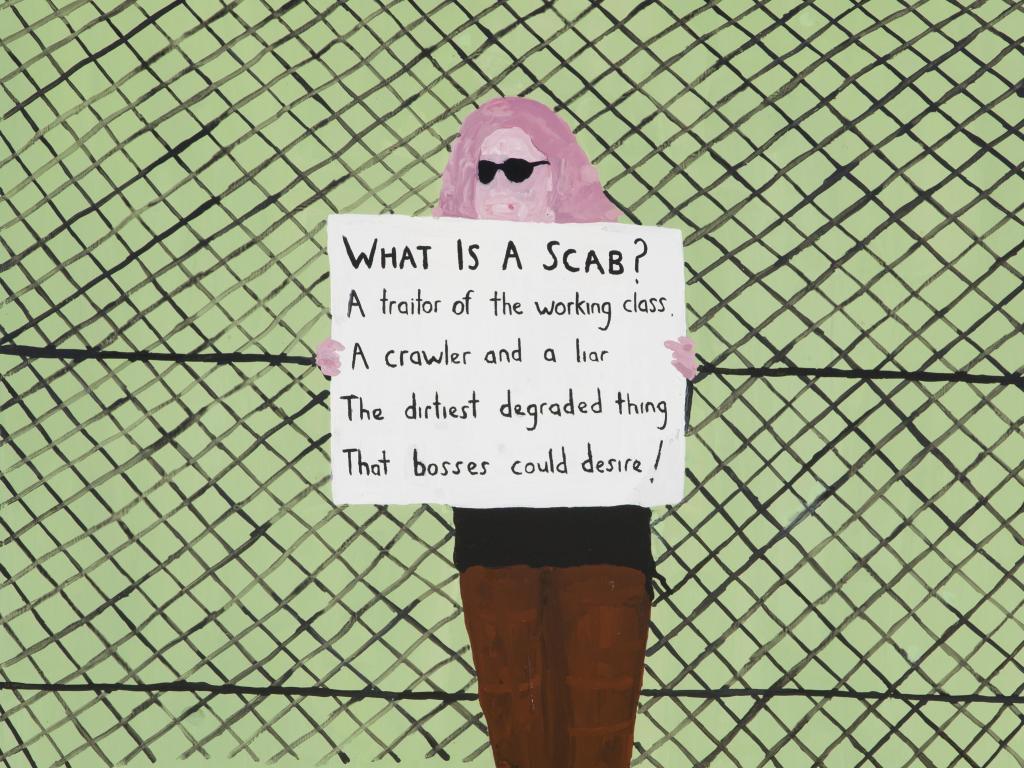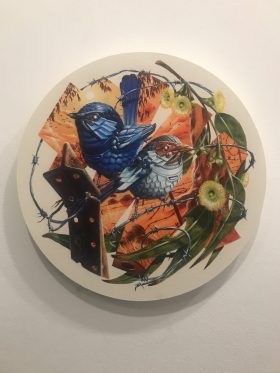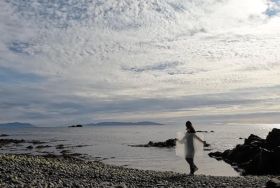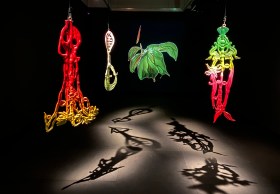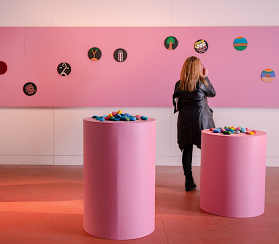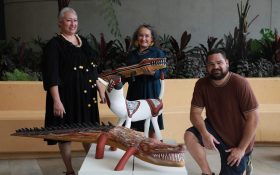Richard Lewer’s What is a Scab? A Traitor… 2011, (detail) oil on canvas 60 x 60cm. Courtesy of the artist and Hugo Michell Gallery, Adelaide.
Currently showing at one of Australia’s oldest and most prestigious ‘sandstone’ universities is an exhibition that explores the relationship between unionism and the arts in Australia. It is also the site at which a protest, leading to one of the most important industrial relations developments in our early labour history began: On the 21 April 1856 stonemasons working on the Old Quadrangle building stopped work and marched from Melbourne University to Parliament House. The eight hour day was born.
Spanning two levels of the Ian Potter Gallery Melbourne University, State of the Union, curated by Jacqueline Doughty, delves into the important collaborations and partnerships between artworkers and the union movement over the past century; a voice of the repressed or a vehicle to evoke change, through banners, posters, documentaries, archival material, photographs, paintings and prints drawn from both public and private collections.
The symbolic connection between the union movement and the university as a place of learning, cultural development and political engagement is a powerful one and easy to overlook in our current climate in which erosion of worker rights and reduced union powers has become the norm. A student Rubbed Their eyes, (2018) by Sam Wallman, vinyl, at the entrance to the exhibition presents a series of vignettes that represent encounters between workers and students on the university campus; a humorous reflection on the exhibition context within this paradigm of privilege.
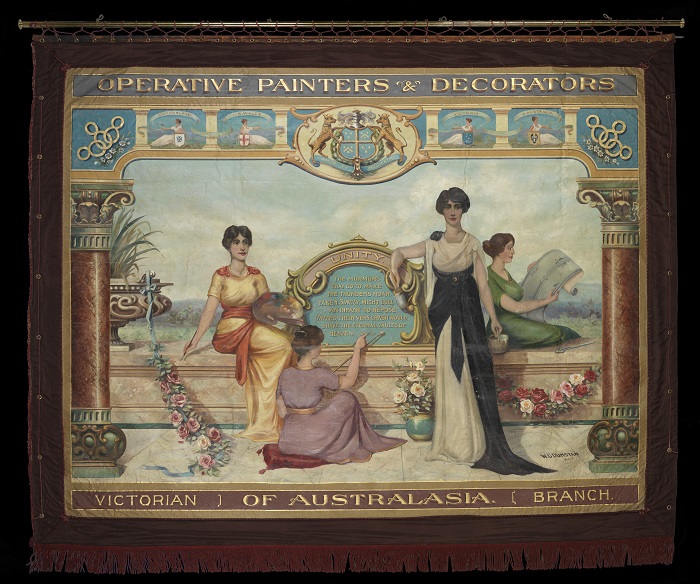
Operative Painters & Decorators Union of Australasia, Victorian Branch, 1915, oil on silk 350 x 430 cm. Courtesy of Museum Victoria and the Construction, Forestry, Maritime, Mining and Energy Union (CFMEU).
The exhibition focus revolves largely around two key time periods where cultural activity between the arts and the labour movement was prominent; the Depression era of the 1930s and 1940s and a later flourishing in the 1970s and 1980s due in part to community arts funding. The archival material interspersed among these works however introduces yet another level of conversation between professions, decades and artists. A work such as Tom Nicholson’s Marat at his last breath, (2018), inject photographic prints on paper, is a new iteration of the 2005 work Flags for Trades Hall Council, where the artist installed four flags on the roof top of the Victorian Trades Hall building as a response to the introduction of regressive Howard government policies. The face on the flags is derived from Jacques-Louis David’s painting, The Death of Marat, (1793), the famous French revolutionary: an ethereal, powerful group of works that invoke the romantic ideal of true commitment to a cause. Alongside this sits the large W.D. Dunstan banner, Operative Painters and Decorators Union of Australasia, Victorian Branch, (1915), oil on silk. It depicts a group of union members dedicated and a proud of their workplace and skill.
This romanisation of the working man and belief that art has the power to instigate societal and political change is reflected in a series of black and white Lino prints on paper (1954). These works by Social Realist artists Peter Lalor, Noel Counihan and Ailsa and Vic O’Connor are a tribute to the Eureka Stockade rebellion of a century earlier. But not all union activity was as honourable; Richard Lewer’s Billy “The Texan” Langley and Funeral of Jack Nicholls, (2011), oil on canvas reflects the darker under belly of union activity during Melbourne’s notorious waterfront wars of the 1960s and 1970s.
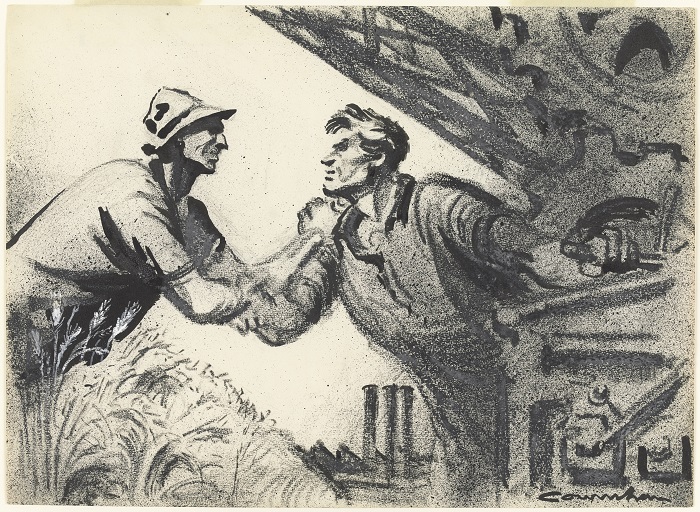
Noel Counihan’s Farmer – Worker Unity, 1940, charcoal, gouache, ink and splatter on paper 28 x 38.4 cm. (c) Noel Counihan/Copyright Agency, 2018.
There were however many dedicated figures who worked hard to promote the rights of workers and the arts. The documentary on legendary union figure and cultural champion George Seelaf illuminates the importance the union movement placed on promoting culture. Founder of the Footscray community Arts Centre and Footscray Historical Society Seelaf also became The Victorian Trades Hall Council’s (VTHC) first Arts Officer on his retirement in 1975.
The success of an exhibition of this size and calibre lies both in the quality of the works and curatorial strength. Doughty’s fine curation allows the viewer to gain a depth of understanding into the relationship between the arts and union movement through careful inclusion and placement of interpretive material. Permanency, (1986), a poster off-set lithograph on paper, by Alison Alder with the title Where could you work for 40 years and still be Temporary? is set alongside print material that investigates the discrimination women continue to face in the paid workforce with casualisation and pay; in many instances still only 75% of a comparative male wage.
Separate rooms dedicated to films such as Im Heung-Soon’s Factory Complex, (2014) provide an international perspective into the exploitation of largely female textile workers in South Korea and Cambodia. A good comparison to work place safe guards we take for granted in Australia thanks to the legacy of our labour movement.
Although there are many art works and a wide range of media along with associated support documentation the exhibition does not feel crowded. Visitor flow around exhibits allows for comfortable viewing and seating is provided for the numerous video installations. Lifts along with stairs provide mobility options and a catalogue with essays by Professor, Andrew Reeves, Senior Research Adviser to the Vice-Chancellor, Deakin University and Imogen Beyond, Organiser, National Union of Workers is available at the front desk. The Potter will also host a series of panel discussions with artists, academics and union officials during the exhibition period.
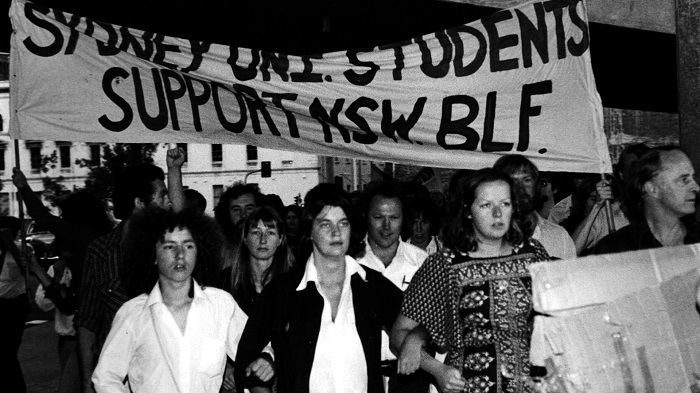
Alex Martinis Roe’s It was about opening the very notion that there was a particular perspective, 2015-2016, video still. Courtesy of the artist, with material courtesy of Meredith Burgmann and Pat Fiske.
Despite the Melbourne, Sydney focus of this exhibition it sheds light on a hugely important working partnership that has impacted social attitudes and provided fertile ground for artistic development regardless of if whether it be ‘high or low art’.
Rating: 4 ½ stars ★★★★☆
State of the Union
The Ian Potter Museum of Art
Free Admission
24 July – 28 October, 2018
Melbourne University, Parkville
